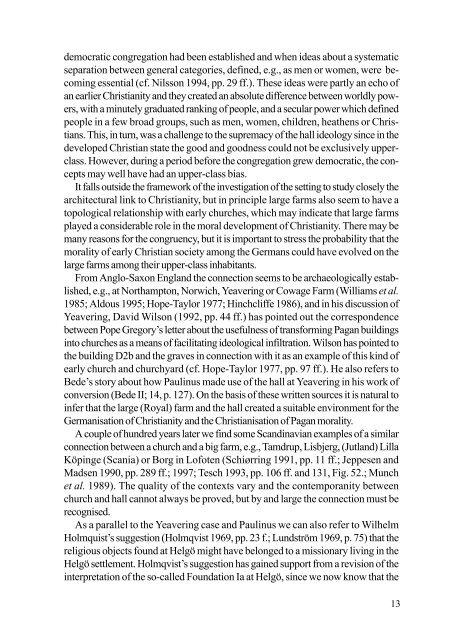Beowulf - Institutionen för arkeologi och antik historia
Beowulf - Institutionen för arkeologi och antik historia
Beowulf - Institutionen för arkeologi och antik historia
Create successful ePaper yourself
Turn your PDF publications into a flip-book with our unique Google optimized e-Paper software.
democratic congregation had been established and when ideas about a systematic<br />
separation between general categories, defined, e.g., as men or women, were becoming<br />
essential (cf. Nilsson 1994, pp. 29 ff.). These ideas were partly an echo of<br />
an earlier Christianity and they created an absolute difference between worldly powers,<br />
with a minutely graduated ranking of people, and a secular power which defined<br />
people in a few broad groups, such as men, women, children, heathens or Christians.<br />
This, in turn, was a challenge to the supremacy of the hall ideology since in the<br />
developed Christian state the good and goodness could not be exclusively upperclass.<br />
However, during a period before the congregation grew democratic, the concepts<br />
may well have had an upper-class bias.<br />
It falls outside the framework of the investigation of the setting to study closely the<br />
architectural link to Christianity, but in principle large farms also seem to have a<br />
topological relationship with early churches, which may indicate that large farms<br />
played a considerable role in the moral development of Christianity. There may be<br />
many reasons for the congruency, but it is important to stress the probability that the<br />
morality of early Christian society among the Germans could have evolved on the<br />
large farms among their upper-class inhabitants.<br />
From Anglo-Saxon England the connection seems to be archaeologically established,<br />
e.g., at Northampton, Norwich, Yeavering or Cowage Farm (Williams et al.<br />
1985; Aldous 1995; Hope-Taylor 1977; Hinchcliffe 1986), and in his discussion of<br />
Yeavering, David Wilson (1992, pp. 44 ff.) has pointed out the correspondence<br />
between Pope Gregory’s letter about the usefulness of transforming Pagan buildings<br />
into churches as a means of facilitating ideological infiltration. Wilson has pointed to<br />
the building D2b and the graves in connection with it as an example of this kind of<br />
early church and churchyard (cf. Hope-Taylor 1977, pp. 97 ff.). He also refers to<br />
Bede’s story about how Paulinus made use of the hall at Yeavering in his work of<br />
conversion (Bede II; 14, p. 127). On the basis of these written sources it is natural to<br />
infer that the large (Royal) farm and the hall created a suitable environment for the<br />
Germanisation of Christianity and the Christianisation of Pagan morality.<br />
A couple of hundred years later we find some Scandinavian examples of a similar<br />
connection between a church and a big farm, e.g., Tamdrup, Lisbjerg, (Jutland) Lilla<br />
Köpinge (Scania) or Borg in Lofoten (Schiørring 1991, pp. 11 ff.; Jeppesen and<br />
Madsen 1990, pp. 289 ff.; 1997; Tesch 1993, pp. 106 ff. and 131, Fig. 52.; Munch<br />
et al. 1989). The quality of the contexts vary and the contemporanity between<br />
church and hall cannot always be proved, but by and large the connection must be<br />
recognised.<br />
As a parallel to the Yeavering case and Paulinus we can also refer to Wilhelm<br />
Holmquist’s suggestion (Holmqvist 1969, pp. 23 f.; Lundström 1969, p. 75) that the<br />
religious objects found at Helgö might have belonged to a missionary living in the<br />
Helgö settlement. Holmqvist’s suggestion has gained support from a revision of the<br />
interpretation of the so-called Foundation Ia at Helgö, since we now know that the<br />
13








